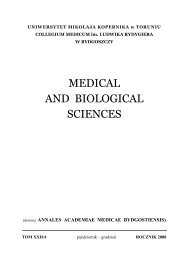Wsparcie spoÅeczne u chorych z miażdżycÄ tÄtnic koÅczyn dolnych
Wsparcie spoÅeczne u chorych z miażdżycÄ tÄtnic koÅczyn dolnych
Wsparcie spoÅeczne u chorych z miażdżycÄ tÄtnic koÅczyn dolnych
Create successful ePaper yourself
Turn your PDF publications into a flip-book with our unique Google optimized e-Paper software.
30<br />
Wojciech Pawłowicz<br />
The dopamine was used in this test as a reference<br />
to the previous studies. The only statistically<br />
significant changes observed were a 15.29%<br />
reduction in pedal wave interval length and a<br />
29,15% increase in the folded area/total foot area<br />
ratio. Other motility variables remained below<br />
statistically significant levels.<br />
subtypes as this enables to fully evaluate the model.<br />
The proposed method is precise and repeatable<br />
enough to be considered for practical use. Also, the<br />
easiness of the process and animal breeding speed<br />
give chances for constituting a cheap and numerous<br />
research groups.<br />
Finally, the role of mucus and its physical<br />
prosperities in the locomotors activity is not to be<br />
excluded. It has been proven before that mucus<br />
plays a key role in snail movement, and here it was<br />
shown that its modification drastically changes the<br />
movement pattern. A question of interest is if, and to<br />
what extent, such changes can be applied to model<br />
epithelium i.e. to modify the adhesive locomotion.<br />
CONCLUSIONS<br />
Fig. 3. Sole of the snail foot with visible pedal waves<br />
(darker areas). 1 – spontaneous movement, 2 –<br />
directly after abroxol injection. The wave length<br />
and intervals between waves have increased<br />
Ryc. 3. Stopa ślimaka z widocznymi falami skurczu<br />
[ciemne rejony]. 1 – ruch spontaniczny, 2 –<br />
bezpośrednio po podaniu ambroksolu. Długość<br />
fali i odległości pomiędzy nimi uległy<br />
zwiększeniu<br />
After the injection of ambroxol, a variety of<br />
changes in the movement pattern could be observed.<br />
The speed of the animals increased by 43,51%, with<br />
both pedal wave length and frequency increasing.<br />
DISCUSSION<br />
The results show a possibility for the use of A.<br />
achatina snail as a study model to test if the<br />
substances influence epithelial motility. The<br />
adhesive locomotion process responded to the<br />
pharmacological modification and thus, leads to<br />
believe that snails use an analogous set of receptors<br />
and neurotransmitters as mammals. The specific set<br />
of changes in movement speed and other variables<br />
differs according to the substance used, but follows<br />
a unique and characteristic pattern.<br />
Being able to use the proposed model efficiently<br />
depends on the specific types of receptors and ion<br />
channels in the snail’s body. The key to the further<br />
studies is to pinpoint their location and specific<br />
1. Serotonin, serotonin-creatinin complex,<br />
norepineprhine and ambroxol injected into snail’s<br />
body cause an overall increase in movement speed<br />
while epinephrine and dopamine have no effect or<br />
decrease movement speed.<br />
2. The increase in movement speed depends on<br />
the increase of pedal wave length, total distance<br />
covered per pedal wave, the pedal wave frequency<br />
and the epithelium fold percentage. Decrease in<br />
movement speed does not cause such changes or is<br />
followed by a decrease of those parameters.<br />
3. It is proposed that in the process of adhesive<br />
locomotion of land snails an important role is played<br />
by epithelial motility regulated by the nervous<br />
system and caused by muscle contraction.<br />
4. The above mentioned snail foot activities<br />
are a valuable biological model for testing if a<br />
substance influences the epithelial motility.<br />
REFERENCES<br />
1. Barker G. M.:. The biology of terrestrial mollusks,<br />
CABI Publishing, New Zeland 2001<br />
2. Lissmann H.W.: The mechanism of locomotion in<br />
gastropod mollusks I. Kinematics, J. Exp. Biol., 1945,<br />
21, 58-69<br />
3. Lissmann H.W.: The mechanism of locomotion in<br />
gastropod mollusks II. Kinetics, J. Exp. Biol., 1945,<br />
21, 37-50,<br />
4. Tyrakowski T., Kaczorowski P., Pawłowicz W.,<br />
Ziółkowski M.:, Discrete movements of foot<br />
epithelium during adhesive locomotion of land snail,<br />
Folia Biol. (Krakow) 2012, 60, 99-106

















